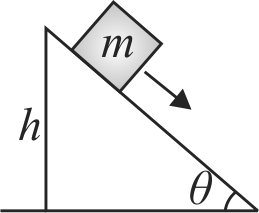355568
A block of mass \(m\) sliding down an incline at constant speed is initially at a height \(h\) above the ground, as shown in the figure. The coefficient of kinetic friction between the mass and the incline is \(\mu\). If the mass continues to slide down the incline at a constant speed, how much energy is dissipated by friction by the time the mass reaches the bottom of the incline?
355568
A block of mass \(m\) sliding down an incline at constant speed is initially at a height \(h\) above the ground, as shown in the figure. The coefficient of kinetic friction between the mass and the incline is \(\mu\). If the mass continues to slide down the incline at a constant speed, how much energy is dissipated by friction by the time the mass reaches the bottom of the incline?
355568
A block of mass \(m\) sliding down an incline at constant speed is initially at a height \(h\) above the ground, as shown in the figure. The coefficient of kinetic friction between the mass and the incline is \(\mu\). If the mass continues to slide down the incline at a constant speed, how much energy is dissipated by friction by the time the mass reaches the bottom of the incline?
355568
A block of mass \(m\) sliding down an incline at constant speed is initially at a height \(h\) above the ground, as shown in the figure. The coefficient of kinetic friction between the mass and the incline is \(\mu\). If the mass continues to slide down the incline at a constant speed, how much energy is dissipated by friction by the time the mass reaches the bottom of the incline?